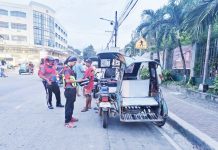
ILOILO City – In Jan. 25, 1948 around 1:46 a.m. a magnitude 8.2 tremor jolted Panay Island and its sleeping people. It destroyed 55 Spanish-era stone churches and triggered a tsunami. What will happen to Panay Island, and specifically to this city, if an earthquake similar to this post-World War 2 tremor called “Lady Caycay” strikes today?
This strong quake will be simulated today as Iloilo City hosts this year’s national simultaneous earthquake drill.
Some 8,000 participants are expected to perform the basic earthquake responses such as “duck, cover and hold” at 2 p.m.
The new Iloilo City Dinagyang Grandstand on Muelle Loney Street will serve as ceremonial venue of the activity.
There will be five drill areas – Barangay Sto. Niño Sur, Arevalo district where a maritime school is based; SM City Iloilo; Iloilo Business Park; Iloilo Mission Hospital; and Iloilo City Hall.
The simultaneous drills will highlight the relationships among different stakeholders in case of emergencies, according to City Disaster Risk Reduction and Management Office head Donna Magno.
“It is always our desire to make our communities resilient against disasters like earthquake and this drill is one of our activities to arm them with the necessary preparedness,” said Office of Civil Defense Region 6 director Jose Roberto Nuñez.
An earthquake impact study on Iloilo City conducted by the Philippine Institute of Volcanology and Seismology (Phivolcs) and Geoscience Australia published in 2012 presented earthquake impact estimates resulting from two earthquake scenarios.
It was determined that a repeat of the 1948 8.2-magnitude earthquake would result in over 8,500 buildings being in a complete damage state (i.e., those that are collapsed or cannot be repaired), and approximately 1,500 fatalities.
The study also projected that a smaller magnitude 6.3 earthquake occurring on a blind thrust about 15 kilometers southwest from Iloilo City would result in approximately 2,700 buildings being in a complete damage state, and approximately 450 fatalities.
The 1948 quake “Lady Caycay” is still considered the second biggest earthquake in the 500-year Philippine earthquake history.
The epicenter was reported to be between Antique’s towns of Tobias Fornier (called Dao at that time) and Anini-y.
The quaking went on for some three minutes, followed by a series of aftershocks which people then said they felt until 5:52 a.m.
Of the 55 damaged Panay churches, 17 totally collapsed, archives showed. These included the churches in Igbaras, San Miguel, Oton and Maasin, all in Iloilo province.
Belfries or church bell towers of San Joaquin, Alimodian, Tigbauan, Dueñas, Dumangas, Guimbal, Lambunao and the Iloilo City district churches in Jaro, Molo and Arevalo were also damaged.
The most prominent of these destroyed belfries was that of the Jaro Cathedral. The first storey of the tower made of limestone and bricks can still be seen today. Its second and third storeys crumbled, and were restored only in the 1990s.
“Lady Caycay” also severely damaged the church and convent of the town of Sta.
Barbara, Iloilo, according to Phivolcs. The temporary belfry reportedly collapsed, too.
The fortress church of Miag-ao, Iloilo luckily incurred less severe damage, according to the Phivolcs study.
Decades later, the Miag-ao Fortress Church would be declared a World Heritage Site by the United Nations Educational, Scientific and Cultural Organization.
According to a Manila Times report dated Jan. 27, 1948, damage estimate for the church in Tigbauan, Iloilo was P50,000 (at that time already a huge amount, equivalent to millions by now).
As an immediate after-effect of “Lady Caycay,” a tsunami was reported from the shores of San Joaquin to Oton, killing two persons.
The Phivolcs study, however, said new archival documents have been unearthed and these can be used to re-evaluate intensities and consequently re-estimate the magnitude of “Lady Caycay.”
According to Phivolcs, at the time of the “Lady Caycay” earthquake, World War II just ended. Most communities were just starting to recover from the disastrous effects of the war and reports were quite sparse; damages due to war and the earthquake were difficult to differentiate.
Using existing reports, there appears to be an incompatibility between intensity distribution and epicenter location and magnitude, the study observed.
“The earthquake’s less serious effects in the epicentral towns of Anini-y and Dao bring the earthquake’s documented location into question,” according to the study.
Earthquake locations at the time of the 1948 earthquake were notoriously poor owing to the sparse global networks, it explained, thus the actual epicenter of “Lady Caycay” could be “up to 100 kilometers in any direction from the documented location.”
How many died or were injured when “Lady Caycay” struck in 1948, the study did not say.
Key government officials here today for the drills include Office of Civil Defense deputy administrator Kristoffrer James Purisima; Undersecretary Reynaldo Mapagua of the Department of National Defense’s Civil Veterans and Retiree Affairs; Undersecretary Renato Solidum Jr. of the Disaster Risk Section and concurrent officer-in-charge of the Philippine Institute of Volcanology and Seismology; Bernardo Florece Jr., undersecretary on peace and order of the Department of Interior and Local Government; and Felicisimo Budiongan, undersecretary for disaster response and management group of the Department of Social Welfare and Development./PN





